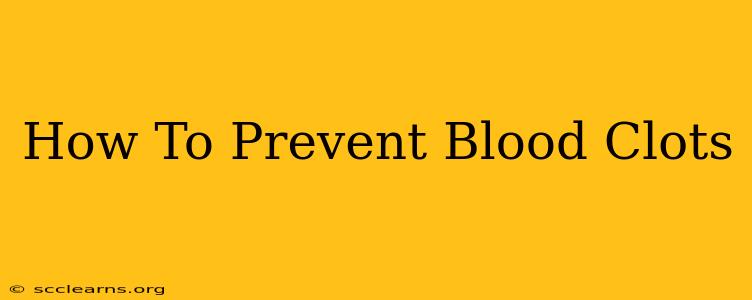Blood clots, also known as thrombosis, are serious medical conditions that can have life-threatening consequences. Understanding how to prevent blood clots is crucial for maintaining good health and reducing your risk of serious complications like stroke, heart attack, and pulmonary embolism. This comprehensive guide will explore various strategies to minimize your risk.
Understanding Blood Clots
Before diving into prevention, it's vital to understand what blood clots are. A blood clot is a solid mass formed from blood components, primarily platelets and fibrin. These clots are essential for stopping bleeding from injuries. However, clots can form inappropriately within blood vessels, obstructing blood flow. This can lead to serious health issues depending on the location of the clot.
Types of Blood Clots
Several types of blood clots exist, each with its own set of risk factors and consequences:
- Deep Vein Thrombosis (DVT): These clots typically form in the deep veins of the legs. They can be asymptomatic, but can lead to pulmonary embolism if they travel to the lungs.
- Pulmonary Embolism (PE): A PE is a blockage in one or more of the pulmonary arteries in your lungs. This is a life-threatening condition that requires immediate medical attention.
- Arterial Thrombosis: These clots form in the arteries and can block blood flow to vital organs like the heart or brain. This can cause heart attacks and strokes.
Risk Factors for Blood Clots
Certain factors significantly increase your risk of developing blood clots. Knowing these risk factors is the first step in effective prevention.
- Family history: A family history of blood clots increases your susceptibility.
- Age: The risk of blood clots increases with age.
- Surgery or prolonged immobility: Extended periods of inactivity, such as after surgery or long flights, can increase the risk.
- Certain medical conditions: Conditions like cancer, heart failure, and inflammatory bowel disease increase the risk.
- Pregnancy and postpartum period: Hormonal changes during pregnancy and the postpartum period increase the risk.
- Obesity: Being overweight or obese increases the risk of blood clots.
- Smoking: Smoking damages blood vessels and increases the risk of clots.
- Birth control pills: Oral contraceptives containing estrogen can increase the risk.
Effective Strategies to Prevent Blood Clots
Preventing blood clots involves a multifaceted approach encompassing lifestyle modifications and, in some cases, medical interventions.
Lifestyle Changes
- Stay active: Regular exercise improves blood circulation and reduces the risk of clots. Aim for at least 30 minutes of moderate-intensity exercise most days of the week.
- Maintain a healthy weight: Losing weight if you're overweight or obese can significantly reduce your risk.
- Eat a healthy diet: A diet rich in fruits, vegetables, and whole grains supports overall cardiovascular health.
- Hydrate: Drinking plenty of water helps to keep your blood flowing smoothly.
- Quit smoking: Smoking significantly increases your risk of blood clots. Seek help to quit if needed.
- Elevate your legs: Elevating your legs when sitting for extended periods can improve blood circulation.
- Compression stockings: Compression stockings can help improve blood flow in the legs, particularly for individuals at high risk, such as those undergoing surgery or on long flights. Consult a doctor before use.
Medical Interventions
For individuals at high risk, a doctor might recommend:
- Anticoagulant medications: These medications, such as warfarin, heparin, or newer direct oral anticoagulants (DOACs), thin the blood and reduce the risk of clot formation.
- Compression therapy: Compression stockings or devices can improve blood flow and prevent clot formation.
When to Seek Medical Attention
It's crucial to seek immediate medical attention if you experience any of the following symptoms:
- Sudden chest pain or shortness of breath: This could indicate a pulmonary embolism.
- Swelling, pain, or redness in one leg: This could indicate a DVT.
- Sudden severe headache or weakness on one side of the body: This could indicate a stroke.
Disclaimer: This information is for educational purposes only and should not be considered medical advice. Always consult with a healthcare professional for any health concerns or before making any decisions related to your health or treatment. They can assess your individual risk factors and recommend the most appropriate preventive strategies for you. Early detection and prevention are key to managing the risk of blood clots.

